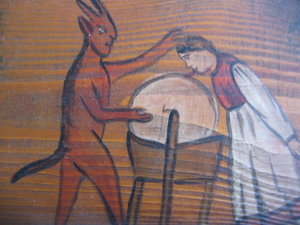Advertisement
Published: February 8th 2009

 Devil Sharpening village gossips tongue
Devil Sharpening village gossips tongue
Example of 17th century bee related folk art(Excerpted from my book Our Summer in Slovenia Amazon.com)
Not in my wildest imaginings, no matter how many hallucinogens I might have taken, would the idea of visiting a bee museum have occurred to me. At first, I thought it was a joke. A "sting" operation on gullible tourists. "Oh, you must not miss visiting the National Bee Museum" in Radovljica, a town of about 6,000 only a ten minute drive from Bled, we were told. "oh sure, The bee museum, wouldn't want to miss that" we replied.
Well, you narrow-minded, pseudo-sophisticate, jaded world-weary traveler who thinks all that is worth seeing has been seen, sit up, take notice. If you haven't been to the Bee Museum, you just haven't been anywhere. You've miss all the buzz. Period.
Actually, the proper name is the Museum of Apiculture (no not acupuncture smart guy).After a pleasant two hours you will have gained knowledge and respect for this tireless worker, this provider of honey, wax, royal jelly and honey liquer; this exemplar of teamwork and devotion, this papal symbol, this humble insect that gives so much and asks for so little, the bee.
So, why here in Slovenia? During the

 Box end in perspective
Box end in perspective
End cover of a bee hive box16th century buckwheat was introduced as a farm product that could be cultivated on the more fallow land of the alpine regions. Bees love buckwheat. They thrive on the flowering plant and soon "...the hills were alive with the sound of buzzing" and Slovenia became noted for its production of honey and wax, wax being especially important during that period for the fine candles it produced.
Austrian Empress Maria Theresa, who ruled over present day Slovenia,, took a special interest and appointed Anton Jansa and the Queen's master bee-guy. He set up field stations in the Karanvanke Alps, near Bled, wrote many scientific treatise on the subject and is recognized around the world today as the Father of modern bee keeping. Bee keeping became an important part of the national livelihood, culture and lore. We saw many artifacts on display in the museum, one being the craft of decorating the ends of the hive boxes with folkloric art representing scenes from everyday life and lore. Some are quite extraordinary. I have one at home, a reproduction no doubt,depicting a peasant woman at a grinding wheel with the devil sharpening her tongue as she was the village gossip.
Advertisement
Tot: 0.521s; Tpl: 0.012s; cc: 10; qc: 48; dbt: 0.1568s; 1; m:domysql w:travelblog (10.17.0.13); sld: 1;
; mem: 1.1mb

 Devil Sharpening village gossips tongue
Devil Sharpening village gossips tongue
 Box end in perspective
Box end in perspective